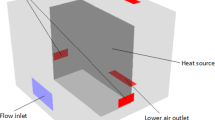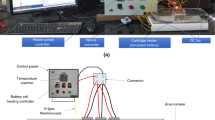Abstract
Heat generation and accumulation during working schemes of the lithium-ion battery (LIB) are the critical safety issues in hybrid electric vehicles or electric vehicles. Appropriate battery thermal management is necessary for ensuring the safety and continuous power supply of rechargeable LIB modules. In this study, thirty cylinder 18650-type cells were fabricated a 6S5P battery module with a 2-mm spacing between cells to evaluate exothermic trajectories. The modules, equipped with a forced-air cooling system, were charged at 1 C-rate and discharged at 1, 1.5, and 2 C-rates for three cycles in each test; thermocouples were connected to the cells to track the variances in temperature and voltage. The efficiency of the developed forced-air cooling system was estimated to be 73.0% in case 1 with the 1 C discharge rate, and the temperature difference (TD) was less than 5.0 °C. The maximum temperature (Tmax) of this case was maintained below 45.0 °C showing uniform heat distribution. Moreover, extreme heat accumulation developed inside the module and damaged the adjacent LIBs during fast 2 C discharge test. Our TD testing showed that a forced-air cooling system in the LIB module provides effective heat dispersion under normal discharge conditions.









Similar content being viewed by others
Abbreviations
- A :
-
Ampere (C s−1)
- a :
-
Constant
- b :
-
Constant
- C:
-
Charge or discharge rate (A s)
- C p :
-
Specific heat (J g−1 °C−1)
- E 0 :
-
Li chemical potential (V)
- F :
-
Faraday constant (96,487 C mol−1)
- G :
-
Gibbs free energy (J)
- I :
-
Current (A)
- m :
-
Mass (g)
- m LIB :
-
Mass of the LIB (g)
- n :
-
nth Order
- p :
-
Power (J)
- P :
-
Pressure (atm)
- Q conv :
-
Heat convection (J)
- Q elect :
-
LIB operating heat in normal ambience (J)
- Q elect, ad :
-
LIB operating heat in adiabatic environment (J)
- Q G :
-
Joule heating (J)
- Q L :
-
Heat loss (J)
- S :
-
Entropy (J °C−1)
- SOC:
-
State of charge (%)
- T :
-
Temperature (°C)
- T amb :
-
Ambient temperature (°C)
- T max :
-
Maximum temperature (°C)
- T LIB :
-
Temperature on the battery surface (°C)
- t :
-
Time (s)
- TD:
-
Temperature difference (°C)
- TDmax :
-
Maximum temperature difference (°C)
- T 0 :
-
Apparent exothermic onset temperature (°C)
- V :
-
Voltage (V)
- v :
-
Volume (m3)
- W :
-
Watt (J s−1)
- w :
-
Inflow wind velocity (8 m s−1)
- x :
-
Charged number carried by the exchanged Li-ion
- y :
-
Constant
- z :
-
Constant
- ΔH :
-
Heat generation (J)
- ΔH ad :
-
Heat generation in adiabatic environment (J)
- ΔH total :
-
Total heat generation (J)
- ΔT :
-
Temperature variation (°C)
- α :
-
Space compactness
- β :
-
Cooling efficiency factor
- η :
-
Cooling efficiency (%)
References
Xun J, Liu R, Jiao K. Numerical and analytical modeling of lithium ion battery thermal behaviors with different cooling designs. J Power Sources. 2013;233:47–61.
Liu Z, Wang Y, Zhang J, Liu Z. Shortcut computation for the thermal management of a large air-cooled battery pack. Appl Therm Eng. 2014;66:445–52.
Zhang T, Gao Q, Wang G, Gu Y, Wang Y, Bao W, Zhang D. Investigation on the promotion of temperature uniformity for the designed battery pack with liquid flow in cooling process. Appl Therm Eng. 2017;116:655–62.
Leng F, Tan CM, Pecht M. Effect of temperature on the aging rate of Li ion battery operating above room temperature. Sci Rep. 2015;5:12967.
Gabrisch H, Ozawa Y, Yazami R. Crystal structure studies of thermally aged LiCoO2 and LiMn2O4 cathodes. Electrochim Acta. 2006;52:1499-06.
Ramadass P, Haran B, White R, Popov BN. Capacity fade of Sony 18650 cells cycled at elevated temperatures: Part I. Cycling performance. J Power Sources. 2002;112:606–13.
NCR18650PF datasheet. Lithium ion NCR18650PF. Panasonic Co., Ltd. (2016, June).
Rao Z, Wang S, Zhang G. Simulation and experiment of thermal energy management with phase change material for ageing LiFePO4 power battery. J Energy Convers Manage. 2011;52:3408–14.
Pesaran AA. Battery thermal models for hybrid vehicle simulations. J Power Sources. 2002;110:377–82.
Hossain S, Kim YK, Saleh Y, Loutfy R. Overcharge studies of carbon fiber composite-based lithium-ion cells. J Power Sources. 2006;161:640–7.
Roth EP, Doughty DH, Pile DL. Effects of separator breakdown on abuse response of 18650 Li-ion cells. J Power Sources. 2007;174:579–83.
Wang Q, Zhao X, Ye J, Sun Q, Ping P, Sun J. Thermal response of lithium-ion battery during charging and discharging under adiabatic conditions. J Therm Anal Calorim. 2016;124:417–28.
Choi YS, Kang DM. Prediction of thermal behaviors of an air-cooled lithium-ion battery system for hybrid electric vehicles. J Power Sources. 2014;270:273–80.
Park C, Jaura A. Dynamic thermal model of Li-ion battery for predictive behavior in hybrid and fuel cell vehicles. SAE Technical Paper, 2003-01-2286; 2003.
Park H. A design of air flow configuration for cooling lithium ion battery in hybrid electric vehicles. J Power Sources. 2013;239:30–6.
Zhang Z, Jia L, Zhao N, Yang L. Thermal modeling and cooling analysis of high-power lithium ion cells. J Thermal Sci. 2011;20:570–5.
Ye Y, Shi Y, Cai N, Lee J, He X. Electro-thermal modeling and experimental validation for lithium ion battery. J Power Sources. 2012;199:227–38.
Kizilel R, Lateef A, Sabbah R, Farid MM, Selman JR, Al-Hallaj S. Passive control of temperature excursion and uniformity in high-energy Li-ion battery packs at high current and ambient temperature. J Power Sources. 2008;183:370–5.
Vitaa AD, Maheshwaria A, Destroc M, Santarellia M, Carello M. Transient thermal analysis of a lithium-ion battery pack comparing different cooling solutions for automotive applications. Appl Energy. 2017;206:101–12.
Basu S, Hariharan KS, Kolake SM, Song T, Sohn DK, Yeo T. Coupled electrochemical thermal modelling of a novel Li-ion battery pack thermal management system. Appl Energy. 2016;181:1–13.
Saw LH, Ye Y, Yew MC, Chong WT, Yew MK, Ng TC. Computational fluid dynamics simulation on open cell aluminum foams for Li-ion battery cooling system. Appl Energy. 2017;204:1489–99.
Linden D, Reddy TB. Electrochemical principles and reactions. In: Reddy TB, Linden D, editors. Handbook of batteries, vol. 3. New York: McGraw-Hill; 2002. p. 2.1–2.37.
Tian Y, Li D, Tian J, Xia B. State of charge estimation of lithium-ion batteries using an optimal adaptive gain nonlinear observer. Electrochim Acta. 2017;225:225–34.
Chung YH, Jhang WC, Chen WC, Wang YW, Shu CM. Thermal hazard assessment for three C rates for a Li-polymer battery by using vent sizing package 2. J Therm Anal Calorim. 2017;127:809–17.
Kizilel R, Sabbah R, Selman JR, AL-Hallaj S. An alternative cooling system to enhance the safety of Li-ion battery packs. J Power Sources. 2009;94:1105–12.
Park M, Zhang X, Chung M, Less GB, Sastry AM. A review of conduction phenomena in Li-ion batteries. J Power Sources. 2010;195:7904–29.
Shahid S, Agelin-Chaab M. Analysis of cooling effectiveness and temperature uniformity in a battery pack for cylindrical batteries. Energies. 2017;10:1157.
Yazami R. Thermodynamics of electrode materials for lithium-ion batteries. In: Ozawa K, editor. Lithium ion rechargeable batteries: materials, technology, and new applications. New York: Wiley; 2012. p. 67–102.
Li J, Chen J, Lu H, Jia M, Jiang L, Lai Y, Zhang Z. A positive-temperature-coefficient layer based on Ni-mixed poly(vinylidene fluoride) composites for LiFePO4 electrode. Int J Electrochem Sci. 2013;8:5223–31.
Saw LH, Ye Y, Tay AAO, Chong WT, Kuan SH, Yew MC. Computational fluid dynamic and thermal analysis of lithium-ion battery pack with air cooling. Appl Energy. 2016;177:783–92.
Karimi G, Li X. Thermal management of lithium-ion batteries for electric vehicles. Int J Energy Res. 2013;37:13–24.
Liu G, Ouyang M, Lu L, Li J, Han X. Analysis of the heat generation of lithium-ion battery during charging and discharging considering different influencing factors. J Therm Anal Calorim. 2014;116:1001–10.
Sabbah R, Kizilel R, Selman JR, Al-Hallaj S. Active (air-cooled) vs. passive (phase change material) thermal management of high power lithium-ion packs: Limitation of temperature rise and uniformity of temperature distribution. J Power Sources. 2008;182:630–8.
Chen CF, Verma A, Mukherjeez PP. Probing the role of electrode microstructure in the lithium-ion battery thermal behavior. J Electrochem Soc. 2017;11:E3146–58.
Acknowledgements
The authors are indebted to the Ministry of Science and Technology (MOST 107-2221-E-224-004-MY3), Taiwan, ROC, for providing financial support for this study.
Author information
Authors and Affiliations
Corresponding author
Rights and permissions
About this article
Cite this article
Wang, YW., Jiang, JM., Chung, YH. et al. Forced-air cooling system for large-scale lithium-ion battery modules during charge and discharge processes. J Therm Anal Calorim 135, 2891–2901 (2019). https://doi.org/10.1007/s10973-018-7646-4
Received:
Accepted:
Published:
Issue Date:
DOI: https://doi.org/10.1007/s10973-018-7646-4




